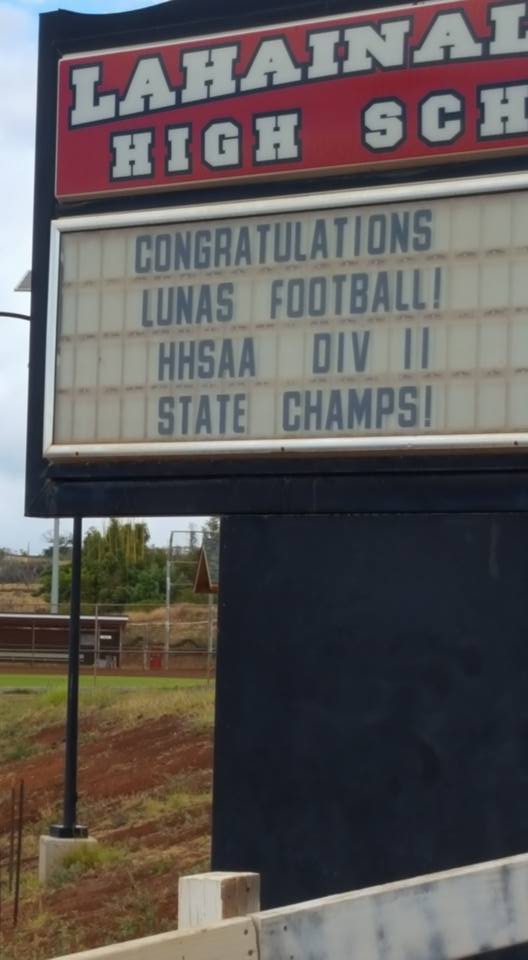Inside Look: Coach Watson Talks Lahainaluna Football, Team’s Journey to D-II Title
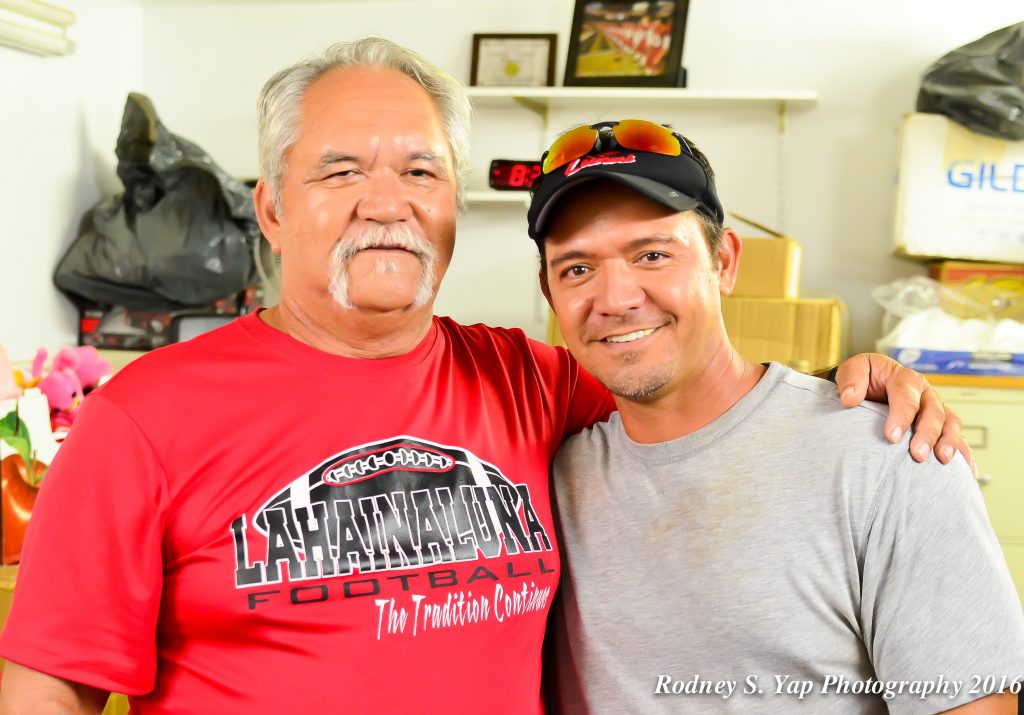
Lahainaluna football coaches Bobby Watson (left) and son Kenui Watson. The coaches help guide Lahainaluna to its first-ever state Division II championship, and talked about the historical journey with MauiNow.com last week. Photo by Rodney S. Yap.
By Rodney S. Yap
He is a man of few words, a deep thinker.
He is a professor in X’s and O’s, who has a passion for U.S. History and would have been a great Social Studies teacher had he chosen the classroom over the football field.
Seems impossible, but nothing about Lahainaluna football is about him, yet everything about the Lunas’ successful program starts and ends with Coach Bobby Watson.
It’s just the way it is at Lahainaluna High School, and it’s been this way now for more than 30 years.
It works, without a hitch, because Watson does not allow his ego to get the best of him. He simply refuses to let his ego or self-worth get tied up in the outcome of a football game.
You will find that philosophy in all of the Lunas’ assistants and the players they coach. It’s a healthy DNA to know that the program is above any one individual — even the head coach.
Parents of Lahainaluna football should not judge their son’s experience based on their interaction with the head coach or any of the coaches for that matter.
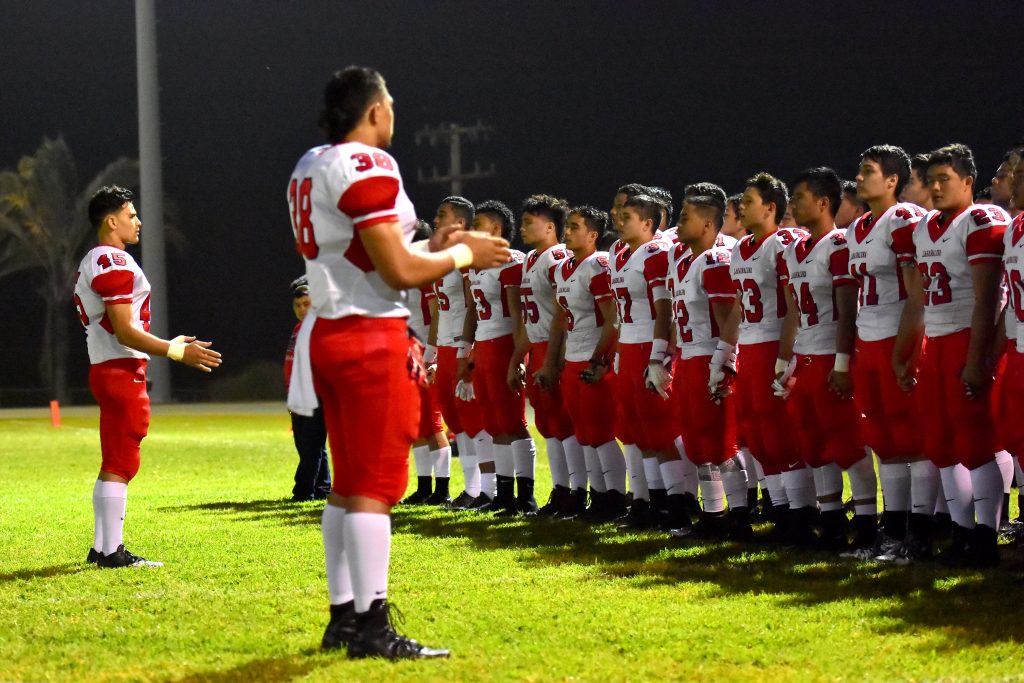
The Lahainaluna football team sings the school’s alma mater prior to playing the Wildcats at Konawaena. Photo by Glen Pascual.
Having trust in the process takes time. However, believing in the important life lessons being taught everyday on the football field, will ultimately provide your son with the tools to handling hardship, rebounding from failure, good sportsmanship, fair play, honesty, trusting your teammate, and dealing with winning and losing.
“The main reason I chose to get into coaching was because of my dad,” said Lahainaluna coach Kenui Watson. “Game planning on defense, gives us father-son time.”
Don’t be fooled, though, “We still argue on the headset, but when its over its over.”
The elder Watson, who has been confine to the coaches box since returning from open-heart surgery more than a year ago, smiled in agreement.
The Watson’s were kind enough to grant this interview, a rare 21/2-hour, talk-story session in Coach Bobby’s upper-campus office.
When it comes to coaching, no one shares the same philosophy as Coach Bobby, like co-head coach Garret Tihada.
And that’s hardly a surprise, considering Tihada played for Watson and has been coaching with him for 28 years, including the last eight seasons as co-head coach.
“For me it’s a no-brainer, it’s easy to do,” Tihada said.
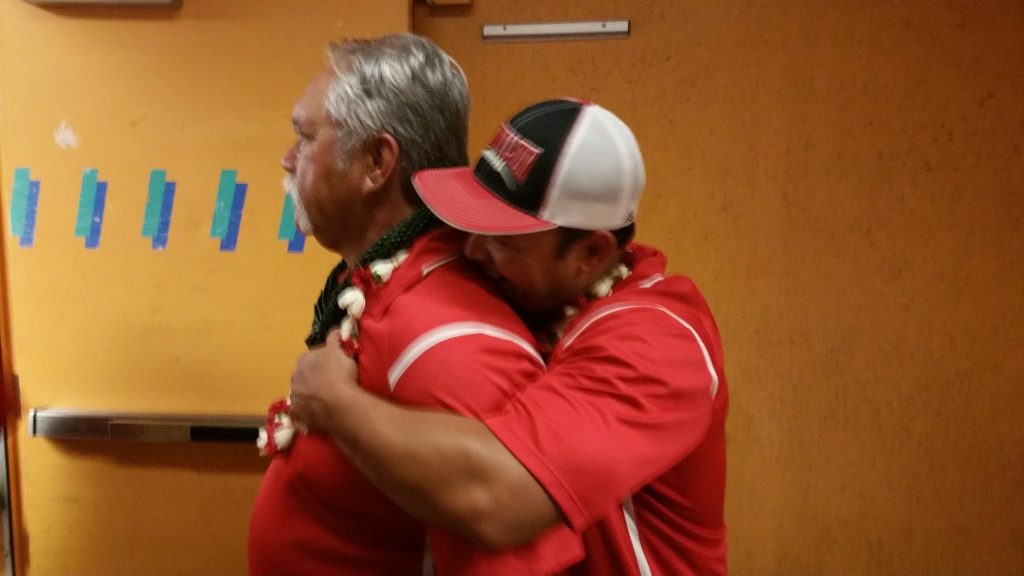
The Watsons, coach Bobby gets a hug from his son Kenui, following the team’s D-II state championship victory against Kapaa at Aloha Stadium. Photo by Glen Pascual.
“We have a lot of people come up to us and say they want their son to play football at Lahainaluna. That’s when Coach Watson and I will look at each other and kind of shake our heads, because we’re on the same page and you don’t really know what it takes to be a Lahainaluna football player. I’m not saying you have to be good, I’m saying you have to fit the mold. You have to be willing to work hard, to get up early in the morning to workout, to take that verbal abuse and open criticism when you make a mistake.”
No player or individual is above or better than the team, which means everyone is subject to an occasional tongue lashing from a coach should he display a lack of effort or perform below expectations.
“We remind them not to take it personal and we are not picking on you,” Coach Kenui said. “Actually we’re trying to get the best out of you, and sometimes that’s how we show it, but really we love you and we want you to be successful.”
Coach Bobby never addresses the team after practice. He leaves the day-to-day stuff to Coach Garret.
“That way the kids don’t get confused,” he said.
COACHING LAHAINALUNA FOOTBALL
“I think there is an understanding, unwritten rule, between Garret and I, that whatever he says goes and I won’t second guess it. Whatever he says is law.”
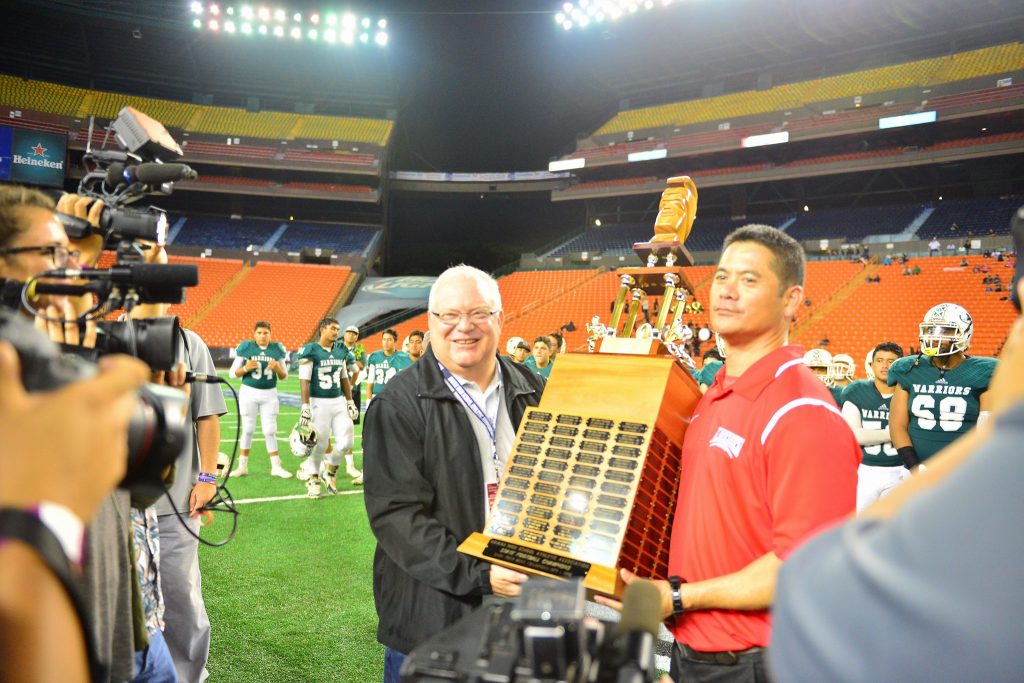
Lahainaluna co-head coach Garret Tihada holds the Division II First Hawaiian Bank State Championship Trophy after beating Kapaa at Aloha Stadium. Photo by Glen Pascual.
Not having Coach Bobby on the sidelines has taken some getting used to, Coach Kenui said.
“His presence alone on the sidelines has an impact, and it’s above anything I can do, or Garret can do.”
Only twice all year Watson felt compelled to talk to the team, and he did so at halftime against Baldwin in the first round and again at Konawaena.
In both situations, Watson was unhappy with the team’s lack of confidence. In his message, the coach challenged the team to play with the swagger he knew they had.
“I tell the players, if you really want to have fun and enjoy this game, you gotta win. That’s what winning does, it’s fun, it makes you feel good — it’s the happiest time.”
“Because of what dad has instilled here, I think we are more family than we are coaches,” Kenui Watson said. “And I guess at the end of the day, nobody is right and nobody is wrong.
“We don’t get involved with the offense and they don’t question the defense. Hopefully what we are trying to do to stop them, and what they are trying to do to score, works. . . . As far as the coaches, everybody has a part, it’s a shared responsibility.”
“This coaching staff could not coach anywhere else,” Coach Bobby said. “We keep it real here. And by us keeping it real, we teach discipline.”
“We have some players who we have to stay on them everyday, and some of them are our better players,” Coach Kenui said. “But what that does is show the other kids that the coaches are not afraid to jump on the starters.”
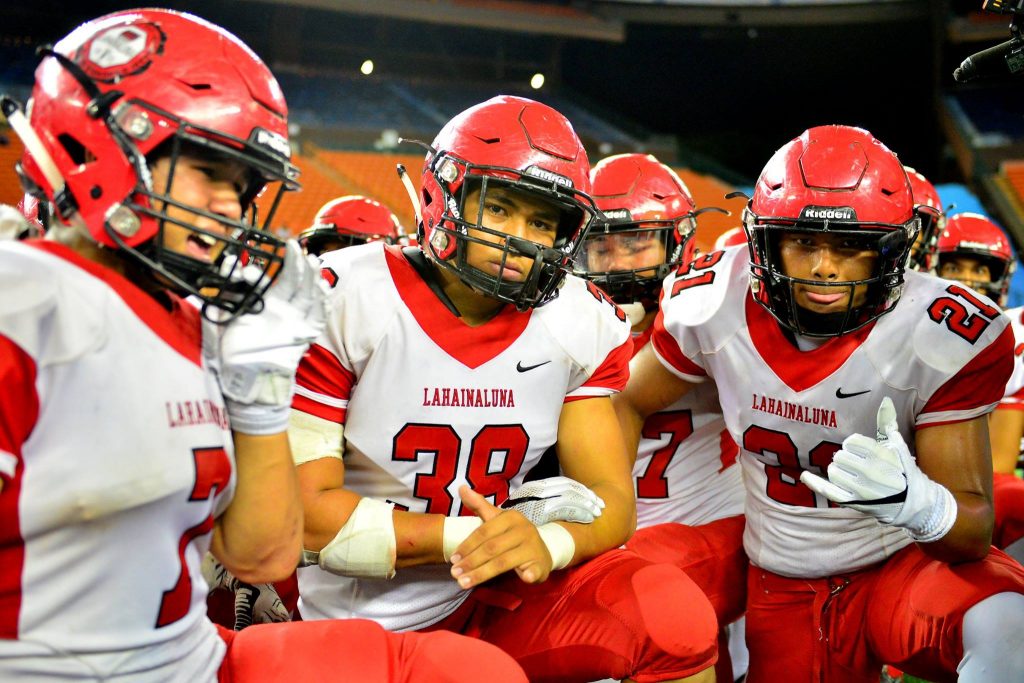
Some of the Lahainaluna players prepare for the trophy celebration after the Lunas defeated Kapaa for the state Division II football championship. Photo by Glen Pascual.
Since joining the Big Boyz League, the bar has been raised at Lahainaluna, and the players today literally compete for playing time each week.
“Oh definitely, because everybody knows that anybody can play and everybody wants to and expects to play,” added Kenui Watson.
“This year we all knew that we had a better team than last year, even though we were smaller and younger, we knew that collectively this team was already better,” Coach Bobby said.
The addition of the Big Boyz League gave the coaching staff a chance to bridge the gap between seniors and underclassmen.
“Because Connor (Mowat) guys were around so long, a lot of the other kids didn’t get playing time, and when they left the void was even bigger,” Kenui explained.
Now the Lunas’ roster is more balanced. The 54-member varsity team has 24 juniors and 11 sophomores returning. Five underclassmen started on defense and eight started on offense. The championship junior varsity team suited up 58 players and the three-time Big Boyz champions had 53 players.
“Now we have kids like Joshua (Tihada), who’s a freshman and he’s running the ball like he’s a senior,” said Bobby Watson.
OFFENSE
Being that football is about blocking and tackling, the offensive line is a constant work in progress, and the primary responsibility of veteran assistant coach Dean Rickard.
“Dean has the hardest position to coach from all of us. Not everyone can block or snap a football,” Coach Bobby Watson said. “He takes it personal and he’s a bit of a perfectionist.
“Dean takes full responsibility for our wins and losses, because in his mind, `it’s on us.’ ”
Three games into the season and the Lunas were reeling. The team had just suffered back-to-back defeats at home, against Kapaa and Maui High, and had not scored an offensive touchdown in eight quarters.
“Our season actually changed when Garret (Tihada) decided to change the offense. And the three best offenses that he knew turned out to be the best thing to happen for us,” Coach Bobby said.
“The problem that we had was we didn’t have the big, strong, dominant linemen like we had when Connor was there. Realizing that our offensive linemen were not like Connor, and they weren’t going to be physical, we had to give them help.
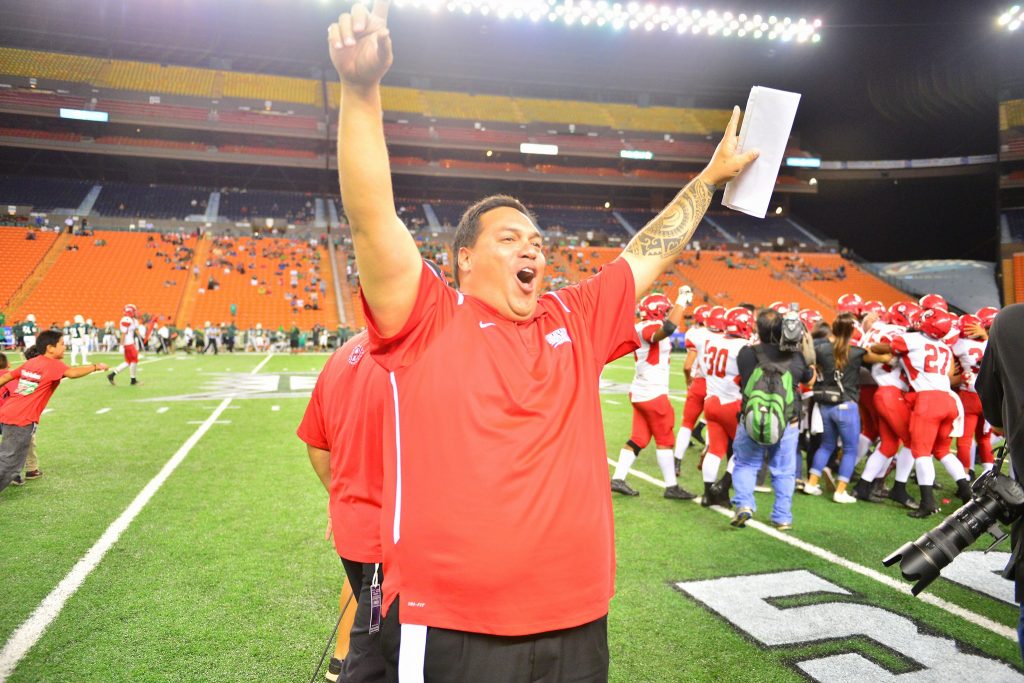
Lahainaluna assistant coach Sonnie Waiohu raises his arms in victory following the Lunas’ Division II victory over Kapaa. Photo by Glen Pascual.
“Since we had an abundance of strong running backs, we decided to use them to help us block. So instead of pulling our linemen, we had our running backs pull and help us trap block. Once he (Garret) did that we had an offense that could move the ball and our defense didn’t have to be out there as long, so that helped the defense.”
The running backs were used as lead blockers in all three schemes — the Wing-T, the Single-Wing and the Wildcat.
“What that did more than anything else was settled the offense down and it took the pressure off the offensive line,” Coach Bobby said.
“He (Garret) initially gave each group just three plays. The change also took the pressure off the quarterback position because each scheme had a different quarterback and each offense ran an equal number of plays — the concept forced everyone to share the responsibility.
“It also worked because Coach Garret had all these young running backs who were good and wanted to contribute. And the sophomore running backs were used to running with other sophomores, because those were the same kids from Big Boyz.”
Against Waipahu, Tihada’s offense scored 52 points to tie the team’s post-season high for points in a game.
“All Waipahu did was blitz, and they showed you what side they were going to blitz, so it was just a matter of running to the opposite side of where they were blitzing,” Coach Bobby said.
DEFENSE
Since defense is about tackling, the Lunas execute one station a day from their progressive tackle playbook.

The players bags lined up at the airport before returning home to the Valley Isle. Photo by Glen Pascual.
“We do circuit training everyday, so one day we will do pursuit drills and another day we will do stripping the ball, but we practice tackling everyday and everybody is seeing the results from that,” said the older Watson.
Coach Bobby watches so much video on that week’s opponent, nothing makes him more angry than a player’s failure to read and recognize the ensuing offensive play.
“I think that’s why I get so upset when I’m upstairs. I showed you the formation, told you what they were going to run off this formation, and showed you where to be to make the tackle.”
So when it happens as scripted, Watson is on the head phones asking for the player to be replaced.
“And when you factor in the fact that we don’t blitz on defense, it makes the read and recognition all the more important,” Kenui said.
“A lot of people don’t realize that we don’t call plays on defense. Nothing. The kids recognize the formation and do all the work off of that. And people asks us what is our base defense (alignment) and I tell them, it depends on what kind of offense you are running, whether we are in a four-man front, or a five, or even a three.”
In Pop Warner, everything is plays, Kenui said, so there’s a disconnect.
“We don’t have plays, everything we do is based on recognition.”
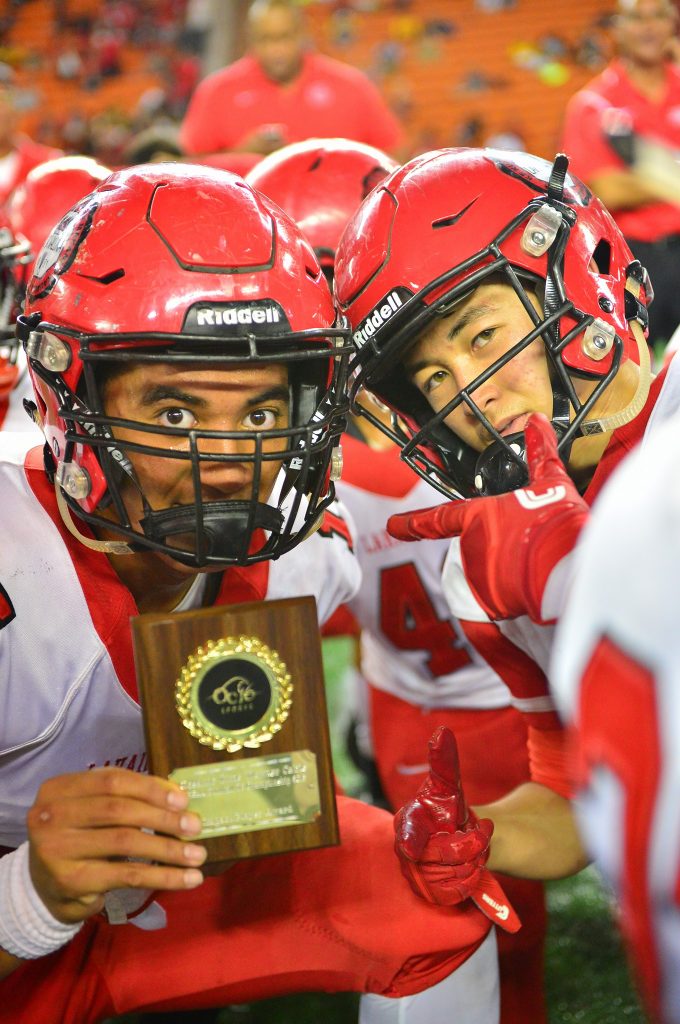
Lahainaluna’s Siale Hafoka poses with his OC16 Impact Player of the Game award. Photo by Glen Pascual.
“Some kids can not stand up and see, others see too much,” Kenui explained. “Those that see too much, are actually thinking too much.”
And then there are players like Hoaka Phillips, who at 5-foot-7, 140 pounds, is the team’s nose guard.
“He knows they have to grab him to slow him down, otherwise he’s going around them and they are to slow to prevent that from happening.”
Sometimes Coach Bobby has the defensive front standup, in a two-point stance, rather than down in a three-point stance.
“This way they can see what’s happening, and see what the quarterback is doing as soon as the ball is snapped instead of having to take the time to look up. Usually, by then, the offensive lineman has you locked up and keeps you in front of him. That’s why our personnel is always changing, allowing different individuals to contribute each week.”
SPECIAL TEAMS
Coach Bobby Watson is also in charge of Special Teams.
Special teams stepped up this year, making a huge impact on field position.
On punt return, deep backs like junior La’akea Shim and freshman Derek Perez fielded the ball on the fly rather then letting the ball bounce, saving the offense 10 to 20 yards to start the next drive.
In addition, place-kicker Pablo Rico’s foot routinely kicked the ball into the end zone, this forced the opposing team to have to go 80 yards.
On kickoffs in past years, the Lunas preferred to squib-kick or kick the ball out of bounds rather than give up a big-play return. But with Rico’s strong leg, the Lunas won the field-position battle and enjoyed the option to kick a field goal in the red zone.
“He did not play football last year, but played Big Boyz as an 8th grader,” Kenui Watson said of Rico. “He’s a goalie on the soccer team and a young weapon. We’re thankful that the kids talked him into playing.”
Against Waipahu and Kapaa, Rico recorded five touchbacks out of 12 kickoffs and averaged 55 yards per kick.
“On special teams we realized we needed speed so we took out all the big guys,” Watson said. “We had to fix our punt return, and we changed some blocking there and then we had to make it fun, so we put in some special plays and the kids started to enjoy themselves.”
The key was putting players in position to have success.
“That block against Kapaa was no accident,” Kenui Watson said. “We worked on that over and over that previous week . . . and the kid (Kupono Kahae-Ampong) actually blocked three of them, two were tipped.”
FUTURE
“When we came home from Kona, I think a lot of our smaller players realized that they can play against bigger linemen and bigger teams,” Coach Bobby said.
“There’s a lot of potential, this junior class is solid and next year they are all going to be 5th-year seniors if you will, having played for us since they were 7th- and 8th-graders. The future looks bright if we continue like we are in the Big Boyz. And as soon as the other teams start to do it, too, our league will get exceptionally better.”



